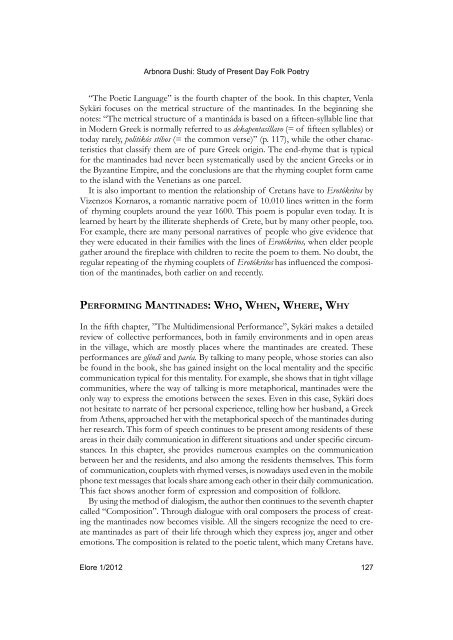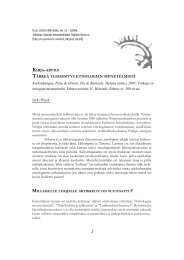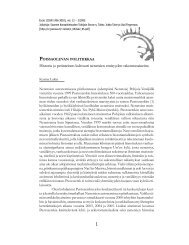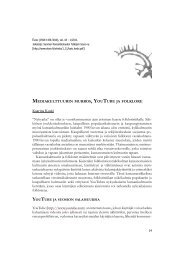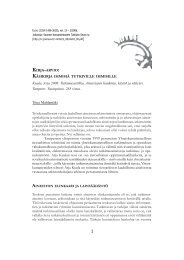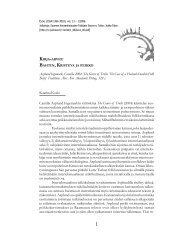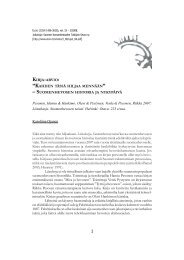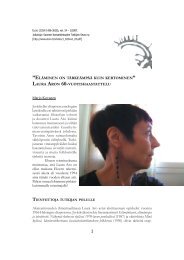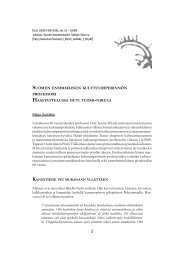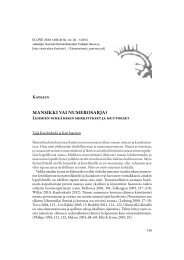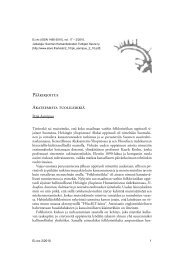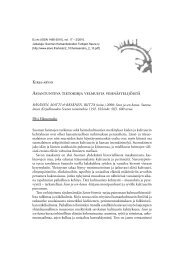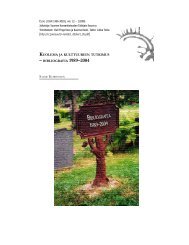Muutoksen tuulia - Elore
Muutoksen tuulia - Elore
Muutoksen tuulia - Elore
Create successful ePaper yourself
Turn your PDF publications into a flip-book with our unique Google optimized e-Paper software.
Arbnora Dushi: Study of Present Day Folk Poetry<br />
“The Poetic Language” is the fourth chapter of the book. In this chapter, Venla<br />
Sykäri focuses on the metrical structure of the mantinades. In the beginning she<br />
notes: “The metrical structure of a mantináda is based on a fifteen-syllable line that<br />
in Modern Greek is normally referred to as dekapentasíllavo (= of fifteen syllables) or<br />
today rarely, politikós stíhos (= the common verse)” (p. 117), while the other characteristics<br />
that classify them are of pure Greek origin. The end-rhyme that is typical<br />
for the mantinades had never been systematically used by the ancient Greeks or in<br />
the Byzantine Empire, and the conclusions are that the rhyming couplet form came<br />
to the island with the Venetians as one parcel.<br />
It is also important to mention the relationship of Cretans have to Erotókritos by<br />
Vizenzos Kornaros, a romantic narrative poem of 10.010 lines written in the form<br />
of rhyming couplets around the year 1600. This poem is popular even today. It is<br />
learned by heart by the illiterate shepherds of Crete, but by many other people, too.<br />
For example, there are many personal narratives of people who give evidence that<br />
they were educated in their families with the lines of Erotókritos, when elder people<br />
gather around the fireplace with children to recite the poem to them. No doubt, the<br />
regular repeating of the rhyming couplets of Erotókritos has influenced the composition<br />
of the mantinades, both earlier on and recently.<br />
Performing Mantinades: Who, When, Where, Why<br />
In the fifth chapter, ”The Multidimensional Performance”, Sykäri makes a detailed<br />
review of collective performances, both in family environments and in open areas<br />
in the village, which are mostly places where the mantinades are created. These<br />
performances are gléndi and paréa. By talking to many people, whose stories can also<br />
be found in the book, she has gained insight on the local mentality and the specific<br />
communication typical for this mentality. For example, she shows that in tight village<br />
communities, where the way of talking is more metaphorical, mantinades were the<br />
only way to express the emotions between the sexes. Even in this case, Sykäri does<br />
not hesitate to narrate of her personal experience, telling how her husband, a Greek<br />
from Athens, approached her with the metaphorical speech of the mantinades during<br />
her research. This form of speech continues to be present among residents of these<br />
areas in their daily communication in different situations and under specific circumstances.<br />
In this chapter, she provides numerous examples on the communication<br />
between her and the residents, and also among the residents themselves. This form<br />
of communication, couplets with rhymed verses, is nowadays used even in the mobile<br />
phone text messages that locals share among each other in their daily communication.<br />
This fact shows another form of expression and composition of folklore.<br />
By using the method of dialogism, the author then continues to the seventh chapter<br />
called “Composition”. Through dialogue with oral composers the process of creating<br />
the mantinades now becomes visible. All the singers recognize the need to create<br />
mantinades as part of their life through which they express joy, anger and other<br />
emotions. The composition is related to the poetic talent, which many Cretans have.<br />
<strong>Elore</strong> 1/2012 127


